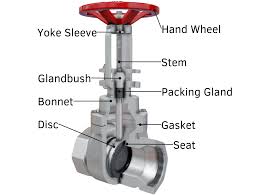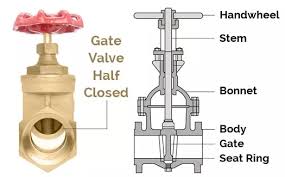Features Types and Structures of Gate Valves

The Application of Classification of Gate Valves
Gate Valves are a versatile and widely used type of industrial valve, finding applications across a diverse range of industries. From basic PVC Gate Valves for water and chemical handling to robust Slide Gate Valves for high-pressure steam systems, gate valves offer reliable flow control and tight shutoff capabilities. 1-2 Gate Valves are a common size range, providing the flexibility to handle a variety of medium to large-scale process applications. Renowned valve manufacturer Cameron offers a comprehensive lineup of advanced gate valve solutions engineered to meet the demands of the most challenging industrial environments.
ball valve leaking
lug vs wafer butterfly valve
cameron gate valve
What Are The Types Of Gate Valves?
Wedge Gate Valves:
The most common type, wedge gate valves use a tapered wedge-shaped gate that seals against the valve seats to control flow. They provide reliable shutoff and are suitable for a wide range of applications.
Parallel Slide Gate Valves:
These valves use a flat, sliding gate that moves parallel to the pipeline to open and close. They are often used in high-pressure and high-temperature applications.
Slab Gate Valves:
Slab gate valves have a single solid gate that moves perpendicular to the pipeline. They provide tight shutoff and are commonly used in pipeline and oil/gas applications.
Knife Gate Valves:
Knife gate valves use a thin, sharp-edged gate that slices through the media to open and close the valve. They are well-suited for handling slurries, liquids with solids, and other challenging fluids.
Double Disc Gate Valves:
These valves have two opposing wedge-shaped gates that close against each other to stop flow. They are often used in nuclear, power generation, and other critical service applications.
Expanding Gate Valves:
Expanding gate valves have a gate that expands outward to seal against the valve seats, providing a tight shutoff. They are commonly used in high-pressure steam systems.
What Is Gate Valves?
Gate Valves are a type of industrial valve used to start, stop, or regulate the flow of fluids, gases, or slurries in a pipeline or process system. They operate by using a movable gate or disc that is positioned perpendicular to the flow, creating an open or closed position to control the medium’s passage. Gate Valves are known for their robust construction, reliable performance, and ability to provide tight shutoff, making them a popular choice across a wide range of industries, including oil and gas, power generation, water treatment, and chemical processing.
How to Select the Right Gate Valves?
Application Requirements: Evaluate the operating conditions, such as pressure, temperature, flow rate, and media compatibility, to ensure the valve can withstand the demands of the system. Valve Size: Choose the appropriate size based on the pipe diameter and flow requirements to optimize performance and minimize pressure drop.
Materials of Construction: Select materials that are compatible with the media and can withstand the operating environment, such as corrosive fluids or high temperatures.
Valve Features: Consider additional features like fire-safe design, extended bonnets, or specialized trim materials to meet specific application needs.
By carefully assessing these criteria, users can select the most suitable Gate Valve to ensure reliable, long-lasting, and safe operation within their process or pipeline system.
Features of Gate Valves
Tight Shutoff:
Gate valves are designed to provide a tight, positive seal when closed, effectively stopping the flow of the process medium. This is achieved through the use of precisely machined valve seats and gate surfaces that form a metal-to-metal or soft-seated seal.
Full Port Design:
Many gate valves feature a full-port design, which means the opening in the valve body is the same diameter as the connecting pipe. This allows for unrestricted flow and minimal pressure drop when the valve is in the open position.
Bidirectional Flow:
Gate valves can typically be installed to allow flow in either direction, providing flexibility in pipeline configuration and flow direction.
Rugged Construction:
The robust body and trim materials of gate valves enable them to withstand high pressures, temperatures, and a variety of corrosive or abrasive media, ensuring long-lasting performance.
Easy Maintenance:
Gate valves often have a simple, straightforward design that facilitates easy disassembly, inspection, and maintenance, minimizing downtime and repair costs.

Advantages and Disadvantages of Gate Valves
Advantages of Gate Valves:
Tight Shutoff: Gate valves provide a reliable, leak-tight seal when closed, making them well-suited for applications requiring positive flow isolation.
High Pressure Capability: The sturdy construction of gate valves allows them to withstand high operating pressures, making them suitable for demanding industrial applications.
Full Flow Capacity: When fully open, gate valves offer a full, unrestricted flow path with minimal pressure drop, enabling efficient fluid or gas transfer.
Bidirectional Flow: Gate valves can typically be installed to allow flow in either direction, providing flexibility in pipeline design and configuration.
Simple Design: The basic design of gate valves simplifies maintenance and repair, reducing downtime and operational costs.
Disadvantages of Gate Valves:
Slow Operation: The perpendicular motion of the gate requires multiple turns of the handwheel to fully open or close the valve, making it a relatively slow-acting design.
Limited Throttling Ability: Gate valves are not well-suited for precise flow control or throttling applications due to their on-off operation.
Susceptibility to Clogging: The gate and valve seats can become obstructed by solid particles or debris in the media, potentially compromising valve performance.
Higher Initial Cost: Gate valves, particularly those with specialized materials or features, may have a higher upfront cost compared to some other valve types.
The Specifications of Gate Valves
| Specification | Value |
|---|---|
| Type | Slide Gate Valve |
| Ball Material | 316 Stainless Steel |
| Attachment Type | Flanged |
| Thread Standard | ASME B16.5 |
| Thread Size | 2 inch |
| Body Material | Carbon Steel |
| Safe for Use With | Water, Oil, Gas, Steam |
| Handle Type | Handwheel |
| Handle Material | Carbon Steel |
| Maximum Working Pressure (psi) | 285 |
| Maximum Working Pressure (bar) | 19.6 |
| Operating Pressure | 150-285 psi (10.3-19.6 bar) |
The Installation Steps for Gate Valves
Site Preparation:
Ensure the pipeline is properly aligned and supports are in place to maintain the valve’s orientation. Clean the pipe ends and remove any debris or burrs.
Valve Orientation:
Determine the correct orientation of the gate valve based on the flow direction and accessibility requirements for the handwheel or actuator.
Valve Placement:
Position the gate valve between the two pipe ends, leaving adequate clearance for the valve body, actuator, and any accessories.
Attachment Method:
For flanged gate valves, align the valve flanges with the pipe flanges and secure the joint using the appropriate bolts, nuts, and gaskets.
For threaded gate valves, apply a suitable thread sealant and carefully thread the valve onto the pipe.
Valve Actuation:
If the gate valve is equipped with a handwheel, ensure it can be easily accessed and operated. For automated valves, connect the actuator to the power source and control system.
Leak Testing:
Perform a thorough leak test on the installed valve to verify a tight seal and identify any potential issues before putting the system into service.
Documentation:
Record the installation details, including the valve model, size, materials, and any relevant process conditions for future reference and maintenance purposes.
The Operation Theory of Gate Valves
Operation Theory of Gate Valves:
Gate valves operate by using a movable gate or disc that is positioned perpendicular to the fluid flow. When the gate is lifted, it creates a full, unobstructed opening that allows the media to pass through. When the gate is lowered, it seats against the valve body, forming a tight seal that stops the flow.
4-inch Gate Valve Operation:
A 4-inch gate valve typically uses a threaded stem that requires several rotations of the handwheel to fully open or close the valve. The gate travels a longer vertical distance within the valve body to provide a full 4-inch opening. This design offers a reliable, bubble-tight shutoff for pipelines carrying liquids, gases, or slurries.
6-inch Gate Valve Operation:
Similar to the 4-inch model, a 6-inch gate valve uses a threaded stem mechanism to raise and lower the gate. However, the larger valve size requires more rotations of the handwheel to fully actuate the valve due to the increased travel distance of the gate. The 6-inch gate valve is well-suited for high-flow applications where a full, unrestricted opening is necessary.